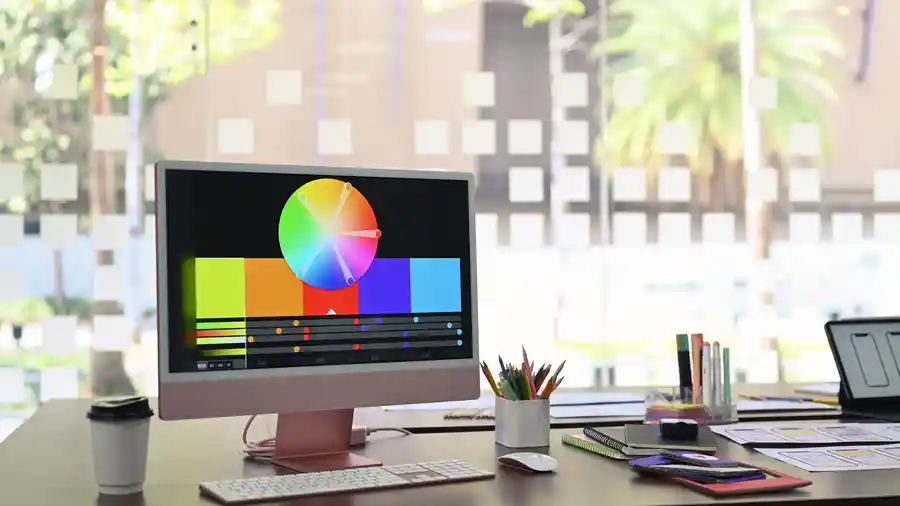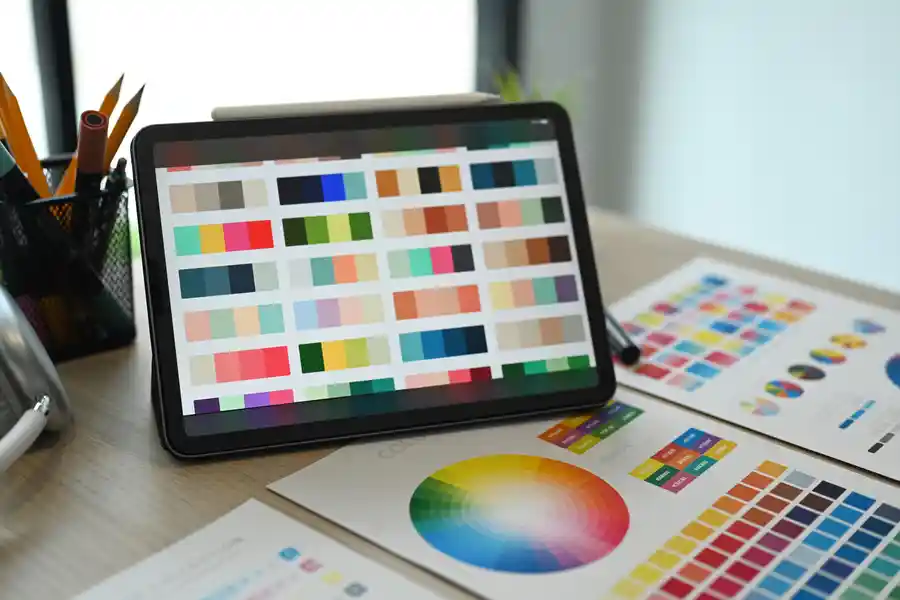In the digital age, understanding how to choose colour combinations for websites is crucial for creating visually appealing and effective designs. 62%-90% of initial impressions are based on colour alone , and 60% of people accept or reject new products based on colour . With such significant impact, choosing the right colours can make all the difference in engaging your audience.
How to Choose Colour Combinations for Websites: Understanding Colour Theory in Web Design
Colour theory plays a pivotal role in web design by helping designers create visually appealing and memorable sites. The isolation effect, for example, suggests that items that stand out are more likely to be remembered. This principle can be leveraged to draw attention to key elements on a page, such as call-to-action buttons or important notifications.
The colour wheel, a fundamental tool in colour theory, aids designers in understanding the relationships between colours. By using complementary colours, which are opposite each other on the wheel, designers can create high contrast and vibrant looks. Analogous colours, which sit next to each other on the wheel, offer more harmonious and subdued combinations.
Additionally, the use of triadic colours, spaced evenly around the wheel, can provide balanced yet dynamic colour schemes. Understanding these relationships allows designers to craft palettes that are not only aesthetically pleasing but also functional.
Incorporating concepts like warm and cool colours can also influence the mood of a website. Warm colours like red and orange evoke energy and passion, while cool colours like blue and green tend to have a calming effect. By strategically selecting and combining these colours, designers can guide user emotions and interactions.
By mastering these principles of colour theory, web designers can create cohesive and compelling user experiences that leave lasting impressions.
The Psychological Impact of Colours on User Experience
Colours can greatly influence user behaviour and emotions. As UI/UX designer Aliza Ackerman advises, “If you’re designing a UI or UX interaction, for example, don’t use blue on your Delete button. You want a colour that acts like a warning”. Furthermore, a study by HubSpot revealed that a red call-to-action button resulted in 21% more clicks compared to a green one, demonstrating the profound impact of colour choice on user interactions.
Colours like red can evoke urgency and excitement, making them suitable for prompts or warnings. On the other hand, green is often associated with safety and approval, ideal for success messages and confirmations. Blue, which instills a sense of trust and calm, is frequently used by financial institutions and tech companies to convey reliability.
The psychological effects of colours are not just limited to individual elements but can also shape the overall atmosphere of a website. Warm colours like yellow and orange are energising and inviting, perfect for retail or entertainment sites. Cool colours like blue and purple can create a sense of calm and professionalism, suitable for corporate or healthcare websites.
Understanding these psychological nuances allows designers to create user experiences that not only look appealing but also resonate on an emotional level, enhancing user engagement and satisfaction.
How to Choose Colour Combinations for Websites: Creating Harmonious Colour Palettes for Websites
Creating harmonious colour palettes is essential for developing a cohesive and visually appealing web design. Aliza Ackerman mentions that she often uses strong colours like red sparingly as accent colours to draw the eye. This technique allows designers to highlight important elements without overwhelming the user.
A well-balanced palette typically includes a combination of primary, secondary, and accent colours. Primary colours form the foundation, while secondary colours add depth and variety. Accent colours, used judiciously, provide visual interest and can guide user attention to key areas.
Designers can also use monochromatic schemes, which involve varying shades of a single colour. This approach creates a sophisticated, unified look that is easy on the eyes. Another method is the use of complementary colours, which can make elements pop and add vibrancy to the design.
When selecting a palette, consider the overall theme and purpose of the website. For instance, an e-commerce site might benefit from energetic and inviting colours, while a corporate site may use more muted and professional tones.
Experimentation is key. Tools like Adobe Colour can help generate palettes based on different colour harmonies, allowing designers to explore various combinations before settling on the final scheme. By thoughtfully combining and applying colours, designers can craft visually engaging and harmonious websites that enhance user experience.
Accessibility Considerations in Colour Choices
Designing with accessibility in mind ensures that websites are usable by everyone, including those with colour vision deficiencies. Approximately 8% of men and 0.5% of women experience some form of colour blindness, making it essential for designers to consider colour contrast and alternative ways of conveying information.
One effective strategy is to ensure sufficient contrast between text and background colours. The Web Content Accessibility Guidelines (WCAG) recommend a contrast ratio of at least 4.5:1 for normal text and 3:1 for large text. Tools like the Colour Contrast Analyser can help designers check their colour choices against these standards.
Additionally, relying solely on colour to convey important information can be problematic. Instead, use text labels, patterns, or icons to supplement colour cues. For instance, error messages can be marked with an exclamation icon and not just a red hue.
Designers should also be mindful of the types of colour blindness, such as deuteranopia, protanopia, and tritanopia, and test their designs accordingly. Simulating these conditions using tools like Colour Oracle can reveal potential issues and allow for adjustments.
By prioritising accessibility, designers can create inclusive web experiences that cater to a wider audience, ensuring that all users can navigate and interact with the site effectively.
Case Studies of Effective Colour Use in Web Design
By examining successful web designs, we can uncover valuable insights into the strategic use of colour. One notable example is Airbnb, which uses a soft, inviting palette of pinks and whites to create a welcoming atmosphere that aligns with its brand values of hospitality and trust. This subtle use of colour helps convey a sense of comfort and belonging, essential for a platform centred around home-sharing.
Another effective use of colour can be seen in Spotify’s vibrant interface. The streaming giant employs a mix of dark backgrounds and bright, contrasting accent colours to highlight key features and content. This not only makes navigation intuitive but also aligns with the brand’s energetic and dynamic persona.
Dropbox also showcases excellent colour use by opting for a clean, blue and white scheme. This choice reinforces the brand’s identity as reliable and professional, catering to business users who require a sense of security and efficiency. Blue is the most popular website colour among consumers, and Dropbox leverages this to instil trust.
The charity: water website stands out with its bold use of yellow, which conveys optimism and hope. This vibrant hue draws attention to their mission and key calls to action, encouraging user engagement and donations.
These case studies demonstrate how thoughtful colour choices can enhance user experience, reinforce brand identity, and drive specific actions. By analysing these examples, designers can gain inspiration for their own projects, ensuring that their colour strategies are both impactful and aligned with their goals.
How to Choose Colour Combinations for Websites: Tools and Resources for Experimenting with Colour Palettes
For designers eager to explore and refine their colour choices, numerous tools and resources are available to facilitate the process. Adobe Colour is a versatile platform where designers can create and explore various colour schemes based on different harmony rules like complementary, analogous, and triadic. Its integration with other Adobe products makes it particularly useful for those already in the Adobe ecosystem.
Coolors is another excellent resource, offering an intuitive interface for generating and sharing colour palettes. Users can lock specific colours and generate new ones to create harmonious schemes quickly. The platform also provides accessibility features to ensure colour combinations are suitable for all users.
For those concerned with accessibility, the Colour Contrast Analyser is an essential plugin. This tool helps designers check the contrast ratios of their colour choices to ensure they meet accessibility standards, making websites more inclusive.
If you’re looking for inspiration, websites like Dribbble and Behance feature numerous design projects showcasing innovative use of colour. These platforms allow you to see how other designers implement colour schemes effectively, offering valuable insights and ideas.
Additionally, plugins like ColourZilla for browsers enable designers to pick colours from any web page and analyse their palettes. This can be particularly useful for dissecting and understanding the colour strategies behind successful websites. By leveraging these tools, designers can experiment with and perfect their colour palettes for any project.
How to Choose Colour Combinations for Websites: Example Colour Palettes for Different Website Themes
When designing for various website themes, selecting an appropriate colour palette can significantly impact user experience and engagement. For a tech-focused website, a sleek and modern palette featuring shades of grey, blue, and white can convey professionalism and reliability. These colours are often associated with innovation and trust, making them ideal for tech companies or startups.
A wellness website, on the other hand, may benefit from a soothing palette of greens, beiges, and soft blues. These colours evoke a sense of calm and tranquillity, aligning well with themes of health, relaxation, and natural beauty. Such palettes can create an inviting and serene user experience, encouraging visitors to explore the content more deeply.
E-commerce websites often use vibrant and energetic colours like red, orange, and yellow to stimulate action and highlight calls to action. These lively hues can draw attention to special offers, discounts, and product features, motivating users to make purchases.
For educational websites, a combination of blues, greens, and neutral tones can establish a sense of credibility and focus. These colours are often linked with knowledge, growth, and stability, making them suitable for learning environments.
Lastly, creative portfolios or art websites can embrace bold and contrasting colours like purples, pinks, and blacks to showcase uniqueness and creativity. This approach can help artists and designers express their personal brand and style effectively.
How to Choose Colour Combinations for Websites: Tips for Implementing Colour Palettes in Your Design
When implementing a colour palette in your design, it’s crucial to maintain harmony and balance. Start by establishing a clear hierarchy, using primary colours for the main elements and secondary or accent colours to draw attention to key areas. Consistency is essential, so ensure that the same colours are used for similar elements across different pages.
Pay attention to contrast, especially for text and interactive elements, to guarantee readability and user accessibility. Testing your design under different lighting conditions and on various devices can help you identify any issues that need adjustment.
Consider the context and emotional impact of your chosen colours. Align your palette with the brand’s identity and the message you want to convey. Tools like style guides can be useful in maintaining consistency across multiple projects or team members.
Lastly, incorporate whitespace effectively to prevent your design from feeling too crowded. Adequate spacing allows the colours to stand out and enhances the overall aesthetic appeal of the website.
Common Mistakes to Avoid When Using Colour in Web Design
When it comes to using colour in web design, several common pitfalls can detract from the user experience. One frequent error is employing an excessive number of colours, leading to a cluttered and overwhelming interface. Stick to a cohesive colour palette to maintain visual harmony and avoid confusion.
Another mistake is neglecting colour contrast, which is essential for readability and accessibility. Ensure that there is sufficient contrast between text and background colours to accommodate users with visual impairments and to meet accessibility standards.
Inconsistent use of colours across different pages or elements can also undermine the user experience. Maintaining consistency in your colour scheme helps reinforce brand identity and provides a more seamless user journey.
Overusing vibrant or saturated colours can also be distracting and strain the eyes. Use bold colours sparingly as accents to highlight important elements rather than overwhelming the entire design. Additionally, failing to test your colour choices on various devices and under different lighting conditions can result in unexpected issues. Always review your design in multiple contexts to ensure its effectiveness.
Ignoring the emotional and psychological impact of colours can also be detrimental. Select colours that align with the brand’s message and the desired user response. By being mindful of these common mistakes, designers can create more effective, aesthetically pleasing, and user-friendly websites.


